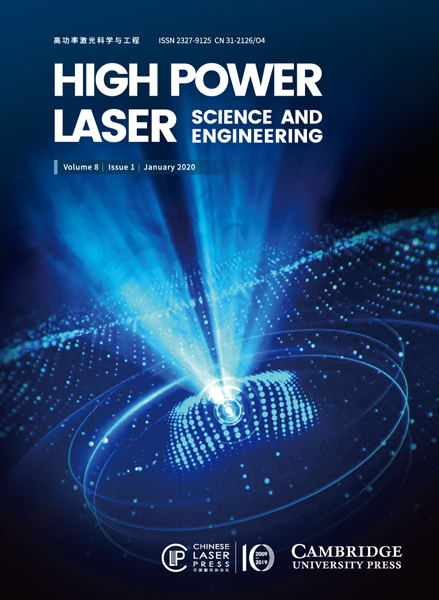2014, 2(4) Column
High Power Laser Science and Engineering 第2卷 第4期
Due to the existence of spatial walk-off and/or group-velocity mismatch effects, pump-to-signal phase transfer becomes inevitable during parametric amplification. We experimentally demonstrate that in hybrid seeded optical parametric amplifiers (OPAs) that include two OPA stages seeded by the signal and idler waves, respectively, the phase of the output signal can be restored to its initial value, although there are spatial and temporal phase fluctuations on the pump source. This method significantly relaxes the requirement for high pump beam quality, which is always very stringent in parametric amplification systems. With the introduction of this scheme into birefringent phase-matching OPAs or chirped-pulse OPAs, it should be promising to achieve intense femtosecond laser pulses that are close to the diffraction limit in space and ultra-high contrast in time, simultaneously.
hybrid seeding parametric amplifier pump-to-signal phase transfer Conceptual designs of a laser plasma accelerator-based EUV-FEL and an all-optical Gamma-beam source Download:880次
Download:880次
 Download:880次
Download:880次Recently, intense research into laser plasma accelerators has achieved great progress in the production of high-energy, high-quality electron beams with GeV-level energies in a cm-scale plasma. These electron beams open the door for broad applications in fundamental, medical, and industrial sciences. Here we present conceptual designs of an extreme ultraviolet radiation source for next-generation lithography and a laser Compton Gamma-beam source for nuclear physics research on a table-top scale.
high peak high average power lasers laser wakefield accelerators High harmonic generation in gas jets was investigated in different gases up to more than 14 bar backing pressure. The observation of increase of harmonic intensity with increasing pressure and laser intensity shows evidence of the presence of clusters in Xe with an increased efficiency compared with He, whereas Ar is an intermediate case for which clusters will start to dominate above a certain backing pressure. Spectral investigations give evidence for tunable harmonic generation in a broad spectral range. A spectral shift of opposite signature caused by the free electrons in the focal volume and the nanoplasmas inside the cluster was observed.
clusters high harmonic generation nanoplasmas ultrashort pulses The energy transfer by stimulated Brillouin backscatter from a long pump pulse (15 ps) to a short seed pulse (1 ps) has been investigated in a proof-of-principle demonstration experiment. The two pulses were both amplified in different beamlines of a Nd:glass laser system, had a central wavelength of 1054 nm and a spectral bandwidth of 2 nm, and crossed each other in an underdense plasma in a counter-propagating geometry, off-set by 10. It is shown that the energy transfer and the wavelength of the generated Brillouin peak depend on the plasma density, the intensity of the laser pulses, and the competition between two-plasmon decay and stimulated Raman scatter instabilities. The highest obtained energy transfer from pump to probe pulse is 2.5%, at a plasma density of 0:17ncr , and this energy transfer increases significantly with plasma density. Therefore, our results suggest that much higher efficiencies can be obtained when higher densities (above 0:25ncr ) are used.
laser–plasma interactions optical pulse generation and compression stimulated Brillouin and Raman scattering ultra-fast optical processes There are several petawatt-scale laser facilities around the world and the fidelity of the pulses to target is critical in achieving the highest focused intensities and the highest possible contrast. The United Kingdom has three such laser facilities which are currently open for access to the academic community: Orion at AWE, Aldermaston and Vulcan & Astra-Gemini at the Central Laser Facility (CLF), STFC (Science and Technology Facilities Council) Rutherford Appleton Laboratory (RAL). These facilities represent the two main classes of petawatt facilities: the mixed OPCPA/Nd:glass high-energy systems of Orion and Vulcan and the ultra-short-pulse Ti:Sapphire system of Astra-Gemini. Many of the techniques used to enhance and control the pulse generation and delivery to target have been pioneered on these facilities. In this paper, we present the system designs which make this possible and discuss the contrast enhancement schemes that have been implemented.
petawatt laser contrast wavefront correction plasma mirror We propose a general methodology to define the optimum doping ion volume distribution required for an efficient solid-state laser amplifier. This approach is illustrated in the context of two experimental diode pumped Yb:YAG amplifiers operating at 300 and 160 K. Processing of such tailored gain media is now possible through horizontal direct crystallization.
diode solid-state laser laser gain medium doping engineering laser materials ytterbium YAG laser A composite transparent YAG/Yb:YAG/YAG ceramic was prepared by a non-aqueous tape-casting method. An optical transmittance of 82% was obtained at visible wavelength and around 1100 nm. A low-threshold, broadband tunable continuous-wave (CW) laser at 1031 nm was further demonstrated from the ceramic sample, which was pumped by a 974 nm fiber-pigtailed laser diode. The threshold pump power was 0.45 W and the maximum output power was 3.2 W, corresponding to a slope efficiency of 20.4%. By inserting an SF57 prism in the laser cavity, the output wavelength could be tuned continuously from 1021 to 1058 nm.
composite transparent ceramic solid-state laser broadband tunable wavelength Optimal laser intensity profiles for a uniform target illumination in direct-drive inertial confinement fusion Download:697次
Download:697次
 Download:697次
Download:697次A numerical method providing the optimal laser intensity profiles for a direct-drive inertial confinement fusion scheme has been developed. The method provides an alternative approach to phase-space optimization studies, which can prove computationally expensive. The method applies to a generic irradiation configuration characterized by an arbitrary number NB of laser beams provided that they irradiate the whole target surface, and thus goes beyond previous analyses limited to symmetric configurations. The calculated laser intensity profiles optimize the illumination of a spherical target. This paper focuses on description of the method, which uses two steps: first, the target irradiation is calculated for initial trial laser intensities, and then in a second step the optimal laser intensities are obtained by correcting the trial intensities using the calculated illumination. A limited number of example applications to direct drive on the Laser MegaJoule (LMJ) are described.
direct drive inertial confinement fusion laser system The dispersion of a pair of prisms is analyzed by means of a ray-tracing method operating at other than tip-to-tip propagation of the prisms, taking into consideration the limited spectral bandwidth. The variations of the group delay dispersion and the third-order dispersion for a pair of prisms are calculated with respect to the incident position and the separation between the prisms. The pair of prisms can provide a wide range of independent and continuous third-order dispersion compensation. The effect of residual third-order dispersion on the pulse contrast ratio and pulse duration is also calculated. The residual third-order dispersion not only worsens the pulse contrast ratio, but also increases the pulse duration to the hundreds of femtosecond range for a tens of femtosecond pulse, even when the residual thirdorder dispersion is small. These phenomena are helpful in compensating for the residual high-order dispersion and in understanding its effect on pulse contrast ratios and pulse durations in ultrashort laser systems.
chirped pulse amplification dispersion prisms ultrashort pulses Recent research activities relevant to high energy density physics (HEDP) driven by the heavy ion beam at the Institute of Modern Physics, Chinese Academy of Sciences are presented. Radiography of static objects with the fast extracted high energy carbon ion beam from the Cooling Storage Ring is discussed. Investigation of the low energy heavy ion beam and plasma interaction is reported. With HEDP research as one of the main goals, the project HIAF (High Intensity heavy-ion Accelerator Facility), proposed by the Institute of Modern Physics as the 12th five-year-plan of China, is introduced.
heavy ion beam high energy density physics ion beam and plasma interaction radiography The Atomic Weapons Establishment (AWE) is tasked with supporting Continuous At Sea Deterrence (CASD) by certifying the performance and safety of the national deterrent in the Comprehensive Test Ban Treaty (CTBT) era. This means that recourse to further underground testing is not possible, and certification must be achieved by supplementing the historical data with the use of computer calculation. In order to facilitate this, AWE operates some of the largest supercomputers in the UK. To validate the computer codes, and indeed the designers who are using them, it is necessary to carry out further experiments in the right regimes. An excellent way to meet many of the requirements for material property data and to provide confidence in the validity of the algorithms is through experiments carried out on high power laser facilities.
high energy density physics HEDP high performance computing HPC high power lasers Experiments have shown that the ion energy obtained by laser–ion acceleration can be optimized by choosing either the appropriate pulse duration or the appropriate target thickness. We demonstrate that this behavior can be described either by the target normal sheath acceleration model of Schreiber et al. or by the radiation pressure acceleration model of Bulanov and coworkers. The starting point of our considerations is that the essential property of a laser system for ion acceleration is its pulse energy and not its intensity. Maybe surprisingly we show that higher ion energies can be reached with reduced intensities.
laser–ion acceleration relativistic laser plasma interaction Output temporal contrast simulation of a large aperture high power short pulse laser system Download:771次
Download:771次
 Download:771次
Download:771次The work presented in this paper is a study of output temporal contrast degradation by near-field quality deterioration, such as intensity modulation and wavefront deviation, in a large aperture high power short pulse laser system. A twostep focusing algorithm with a coordinate transform based on the Fresnel approximation in the space domain is used for simulating the output focused by an off-axis parabolic mirror. The temporal contrast degradation by intensity modulation and wavefront deviation is analyzed and the influence of the diameter on the temporal contrast degradation is revealed. The simulation and assumption results based on the parameters of the Shen Guang-II laser system are compared with the online experimental temporal contrast data. The near-field quality deterioration might lead to temporal contrast degradation, hindering higher temporal contrast in large aperture high power short pulse laser systems.
fill factor of laser beam temporal contrast ultrafast optics wavefront deviation 动态信息
动态信息 丨 2023-06-21
HPL Highlight (Vol. 11, e40): NIF仍然是全球唯一一个能够进行ICF点火实验的装置动态信息 丨 2023-06-21
HPL Highlight (Vol. 11, e9): 变分神经网络预测激光尾波场加速电子能谱动态信息 丨 2023-06-21
HPL Highlight (Vol. 11, e7): 目标探测网络加入,激光等离子体加速器实现实时诊断动态信息 丨 2023-06-21
HPL Highlight (Vol. 11, e5): 910 nm波段超宽带种子源,向100 PW超强超短激光进发动态信息 丨 2023-06-21
HPL Highlight (Vol. 11, e4): 100 PW单束压缩!多步压缩器进阶双光栅激光评论微信公众号

点击菜单“联系编辑”即可添加期刊编辑为好友啦
















